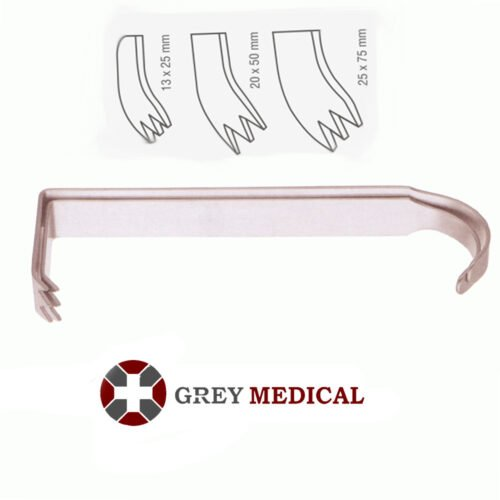
The Hibbs retractor is a vital instrument in the field of surgery, known for its versatility and effectiveness in providing optimal exposure of the surgical site. Named after Dr. William Hibbs, this hibbs retractor has become a staple in orthopedic and general surgical procedures. Its robust design and functional utility make it indispensable for surgeons who require reliable tools to facilitate their work.
Design and Features of the Hibbs Retractor
The Hibbs retractor is characterized by its sturdy, stainless steel construction, which ensures durability and resistance to corrosion. It features a broad, flat blade at one end and a handle at the other, allowing for a secure grip and easy manipulation. The blade is typically curved or straight, depending on the surgical requirement, and is designed to retract tissues or organs, providing clear visibility and access to the surgical area.
The handle is ergonomically designed to offer comfort and reduce hand fatigue during prolonged use. The length and width of the blade vary, offering flexibility to surgeons in choosing the most suitable retractor for different procedures. Some versions of the Hibbs retractor are also equipped with a toothed edge, enhancing their ability to hold tissues firmly in place.
Applications of the Hibbs Retractor
The Hibbs retractor is predominantly used in orthopedic surgery but also finds application in various other surgical disciplines. Its primary function is to retract soft tissues, muscles, and organs, ensuring that the surgeon has a clear and unobstructed view of the surgical site. Some common applications include:
- Orthopedic Surgery: In orthopedic procedures, the Hibbs retractor is frequently used to expose bones and joints. Its sturdy design allows it to hold back thick layers of muscle, providing the surgeon with a stable and clear view of the operative field. It is particularly useful in hip and spine surgeries, where deep and wide exposure is necessary.
- General Surgery: In general surgery, the Hibbs retractor aids in abdominal procedures by retracting the abdominal wall or other organs, facilitating access to the target area. Its ability to handle large tissues makes it ideal for surgeries that require extensive exposure.
- Neurosurgery: The Hibbs retractor is occasionally used in neurosurgical procedures to retract muscles and tissues during spinal surgeries. Its robust design helps maintain a stable surgical field, which is crucial in delicate operations involving the spinal cord.
Advantages of the Hibbs Retractor
One of the significant advantages of the Hibbs retractor is its versatility. It can be used in a variety of surgical settings, making it a valuable addition to any surgical instrument set. Its ability to provide wide and deep exposure helps reduce the risk of complications by allowing surgeons to operate with better visibility and precision.
The ergonomic design of the handle enhances the surgeon’s comfort, which is particularly important during long and complex surgeries. The robust construction ensures that the retractor can withstand the mechanical stresses of surgery without bending or breaking, thereby maintaining its effectiveness over time.
Additionally, the Hibbs retractor’s ability to hold tissues securely minimizes the need for frequent repositioning, saving time and reducing the risk of tissue damage. This feature is particularly beneficial in surgeries that require prolonged retraction.
Care and Maintenance
To ensure the longevity and effectiveness of the Hibbs retractor, proper care and maintenance are essential. After each use, the retractor should be thoroughly cleaned to remove any blood, tissue, or other contaminants. Sterilization is crucial to prevent infections and maintain a sterile surgical environment.
Inspecting the retractor for signs of wear or damage is also important. Any signs of corrosion or mechanical defects should be addressed promptly to avoid compromising the retractor’s performance. Proper storage in a clean, dry environment helps preserve the instrument’s integrity and readiness for future use.
Conclusion
The Hibbs retractor is a fundamental instrument in surgical practice, offering unparalleled support in procedures that require deep and extensive tissue retraction. Its robust design, versatility, and reliability make it a favorite among surgeons across various specialties. By providing a stable and clear view of the surgical site, the Hibbs retractor plays a crucial role in enhancing surgical outcomes and patient safety. Proper care and maintenance of this instrument ensure that it continues to serve as a valuable tool in the operating room for years to come.